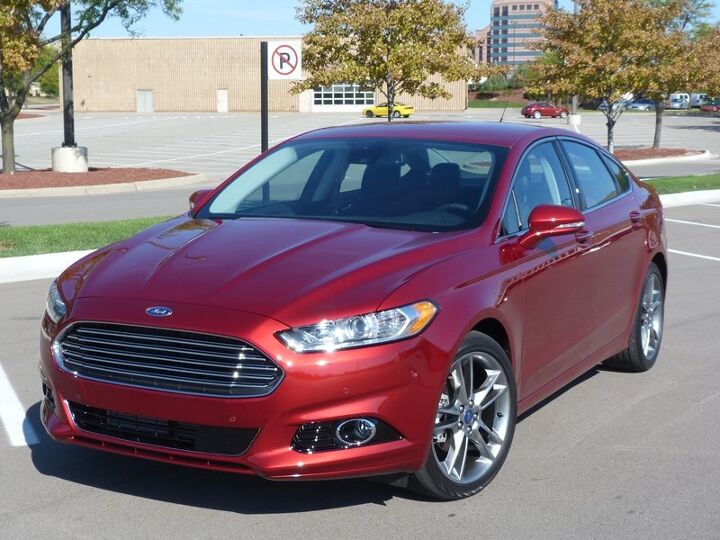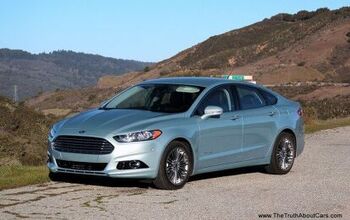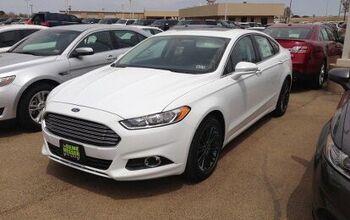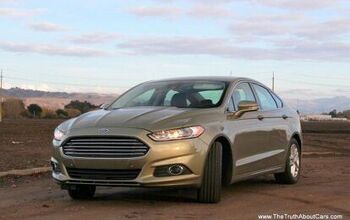Review: 2013 Ford Fusion
I hate to review mass market midsize sedans. Especially with the latest round—every key player save the Sonata has been redesigned in the past 18 months—all are good cars. But they’re also all boring. Given the large number of conflicting criteria that must be met for a shot at segment leadership and the rarity of solutions that dramatically push the envelope, all serious players have devolved into highly competent appliances. Then we have the 2013 Ford Fusion.
Midsize car buyers tend to be conservative (in their automotive tastes, not necessarily their politics). To avoid upsetting them, the latest Accord and Camry look much like the cars they replaced. (I’m still learning how to infallibly distinguish the new Honda.) Chevrolet decided that the way to beat them was to dress like them. The new Volkswagen Passat could have been designed two decades ago. The new Nissan Altima looks new—if you pay really close attention. Only the Hyundai Sonata has taken big aesthetic risks. This gamble has won more sales than it has lost, but it has lost more than a few.
The new Ford Fusion resembles none of the above. Does the grille owe a bit much to Aston? Will TPTB feel the need to change things up yet again long before we might come to see this front end and think Ford first? Perhaps. There’s also more than a little A7 in the rear three-quarter view.
But what can’t be denied is that the ends of the car manage to be at once stylish, very different from the segment norm, and appealing to a broad range of potential buyers. Nothing crazy has been done with the lamps, or with chrome detailing. The designers also engaged in a minimum of cheating, with no black triangle in the C-pillar and just an itty-bitty one in the A-pillar. My largest personal complaint about the exterior is that, when combined with multi-spoke wheels, the midsection appears distended and stiff.
Five-spoke rims fix this.
Ford has taken far fewer risks inside the car. The new Fusion’s interior is considerably more conservative than its exterior and than the interiors of other recently designed Fords.
Tradeoff Style vs. Space
Many midsize sedan buyers demand roomy cabins and capacious trunks. Highly prioritize this imperative, and you end up with all the curves of a Camry. Well, the new Fusion is chock full of curves, yet it also matches competitors inch for inch and cubic foot for cubic foot. Exterior dimensions (191.7×72.9×58.1 inches) are virtually identical to the Passat’s, while interior dimensions and trunk space meet or beat the limo-like VW’s (with an extra inch of both combined legroom and front shoulder room). Some of this might be due to creative measuring—in person, the Passat seems to have more legroom.
But, due to a large, high-mounted, and very well shaped rear seat, the Fusion is the midsizer I’d personally prefer to be chauffeured in. The Ford’s front seats are also very comfortable and supportive, especially those in the top-level Titanium. But the development team might have gone a bit far with their side bolsters. They’re about perfect for me, but those with waistlines well beyond 33 inches mind find them overly tight.
Tradeoff Style vs. Forward Visibility
Most midsize sedans have very good forward visibility because their designers weren’t allowed to draw anything swoopy. Check out a recent Hyundai front-drive sedan to find out what happens to the pillar rake and instrument panel depth when the creative types are unleashed. Or check out the new Ford Escape. With the Fusion, while the overall exterior appearance is very sleek the angle of the A-pillars is relatively conservative. Consequently, the view forward is more Passat than Sonata.
Tradeoff HMI Style vs. Functionality vs. Usability
When I first saw MyFord Touch, with its trio of vivid highly configurable displays, I was wowed. So pretty, and capable of handling so many functions via touch or voice, clearly this was the future. Everyone else’s controls suddenly seemed archaic. The problem was, with so many little virtual buttons, MFT was too hard to actually use while driving, at least via touch.
Ford has reacted to widespread criticism, some of which has gone so far as to recommend against buying any car with the system, by repeatedly tweaking the software. This has helped, but quite a few screens continue to contain an overly large number of overly small buttons. The new Fusion incorporates a larger improvement: the touch-sensitive display is located closer to the driver, and is mounted flush with the center stack rather than recessed. This makes it much easier and more comfortable to operate.
You can always get the SE without MFT (it’s standard on the Titanium). But then the center stack looks like this:
Tradeoff Build Quality vs. Affordability
Honda, Toyota, and Volkswagen have all obviously cut corners in pursuit of lower costs. The materials inside the new Fusion are much nicer than in any of them. The impact of CEO Alan Mulally’s “One Ford” imperative, due to which this car must be competitive in Europe as well as North America, is evident. Aside from a trio of LCD panels, there’s nothing flashy or overtly luxurious—there will be the Lincoln MKZ for this. But the parts seem solid, look precisely assembled, and feel soft to the touch in all the places that count. Within the segment, only the new Malibu might do better.
Ford has rarely tried to sell Euro-spec cars in the U.S. in the past because European build quality tends to require European prices. Even the U.S.-spec Passat is the most expensive car in the segment. I fully expected Ford to have to price the Fusion similarly.
But they haven’t. A Fusion SE 1.6T manual with Appearance Package, arguably the most enjoyable of the bunch, lists for $25,745. For more power, luxury, and gadgetry, step up to the Titanium. With sunroof, it’s $31,890. A Passat V6 SEL Premium is nearly $2,500 more. Adjust for the Ford’s additional features using TrueDelta’s car price comparison tool, and the difference widens to nearly $4,000. More interested in peak efficiency? The Fusion SE Hybrid, equipped similarly to the Camry Hybrid XLE, undercuts the Toyota by a couple hundred dollars with a base price of $27,995.
How did Ford manage this? Beats me. They will be assembling the new Fusion with minimal variation in at least five plants worldwide (Michigan, Mexico, Belgium, Russia, China). Perhaps they’ll be “making it up in volume.”
Tradoff Build Quality vs. Curb Weight
Premium materials and solid body structures don’t only tend to add cost. They also tend to add weight. Ford’s Fiesta, Focus, and Escape are each among the heaviest cars in their respective segments. With the most popular powertrain (1.6T auto) checking in at 3,421 pounds, he Fusion similarly outweighs the Accord, Camry, Passat, and Sonata by about 200 and the Altima by about 300. No envelope pushed here.
Tradeoff Performance vs. Fuel Economy
With its higher curb weight, the 2013 Fusion should have a hard time matching the performance and fuel economy of its competitors, much less managing both. Yet the redesigned Hybrid achieves 47 miles-per-gallon in both EPA tests, city and highway. These numbers top the Camry Hybrid’s by four and eight MPG, respectively, and aren’t far behind those of the smaller, lighter, much less powerful Prius (51/48). To achieve these numbers, Ford reduced the size of the gas engine from 2.5 to 2.0 liters then tuned the system to operate the smaller engine at lower rpm and a higher load. To compensate for the resulting engine thrum, they added active noise reduction (which plays the opposite sound through the stereo speakers, canceling it out). Ford also claims to know more about electric motors and batteries than other competitors, and to have applied this knowledge very effectively. The switch from a NiMH to a Li-ion battery pack capable of higher output and deeper cycling gets some specific credit. Ford claims that one competitor is overly attached to NiMH.
But if the new Fusion Hybrid performed poorly, only those fanatically focused on MPG would want it. Banish the thought. The Camry Hybrid is capable of quicker acceleration, given more power (200 vs. 188 horsepower combined) and fewer pounds (3,417 vs. 3,615), but the Fusion Hybrid is much more satisfying to drive quickly, with a smooth, torquey power flow that feels more like that of a conventional engine and a much more capable chassis. This isn’t entirely a good thing. While the Toyota’s character encourages light-footed driving, the Ford’s does not. Drive it casually, and it feels good. Drive it hard, and it feels better–but fuel economy will suffer.
There’s a fix for this as well: the best driver feedback yet seen in a hybrid. The instruments are configurable in more ways than I cared to count. You can view various combinations of tachometer, engine output, electric motor output, battery charge level, instantaneous fuel economy, average fuel economy, and driving style scores (with the last much like those in the Prius c). In the past I’ve asked why no hybrid provides an indication of the percentage of energy recouped through regenerative braking, as an indicator of how hard you can brake without compromising fuel economy. After all, the key efficiency benefit of a hybrid follows from this regenerative ability (or lack thereof). Well, the new Fusion Hybrid gives you a percentage of energy recouped each time you brake to a stop.
This said, they’ve also left something out: there’s no instantaneous evaluation of driving style aside from the indicators of engine and motor output, with a mark noting the maximum possible in EV mode. The Ford engineer claimed that they decided that overly involving instantaneous feedback would prove an unsafe distraction. I’m not quite buying this. If the display is located high enough, you can simultaneously keep an eye on both it and the road. But the Fusion’s displays are conventionally located.
My driving route was insufficiently urban to adequately test the Fusion Hybrid’s fuel economy. With a cruising speed of 48 and few complete stops, but also a few foot-to-the-floor events, the trip computer reported high 40s.
Sound good? Well, on the same route (but with even fewer stops and a lighter foot on the go pedal) the trip computer in a Fusion SE with the 178-horsepower 1.6-liter turbocharged four-cylinder engine and a six-speed manual transmission reported 46.5 MPG. Granted, these were ideal conditions for maximum fuel economy. In typical suburban driving I suspect this powertrain will roughly split the EPA ratings of 25 city, 37 highway. Performance with this powertrain is about what you’d expect from a 3,333-pound car with 178 horsepower: beyond adequate, but not too far beyond. Ford hasn’t worked any miracles here. Shift feel could be much worse, but it could also be much better. One of the few improvements I’d very much like to see is a shifter that feels more like the one in the Mazda3 SKYACTIV. But I suspect that the Mazda’s shifter employs a rod, while the Ford’s (if feel is any indication) very likely pushes and pulls a cable.
The Fusion’s top engine, a 2.0-liter turbocharged four-cylinder engine, seems the most curious choice. Chevrolet and Hyundai also offer 2.0T’s instead of V6s, but they produce more peak horsepower, 259 and 274 vs. the Ford’s 240. And this 240 only happens with premium unleaded. Put in regular, and it drops to 231. The V6s in the Accord, Altima, Camry, and Passat all produce between 268 and 280 horsepower. Less power to move more weight doesn’t seem a recipe for competitive performance.
The reality isn’t as bad as these numbers suggest. There’s no magic involved, just torque. The Ford 2.0T (standard in the Titanium, a $1,000 bump over the 1.6T in the SE) peaks at 270 pound-feet, higher than any of the others (though just barely higher than the Hyundai). So through the midrange the Ford engine does at least as well as the others. So while the Ford won’t be as quick in full throttle acceleration, in typical daily driving it’ll perform about as well. At part throttle through the midrange there are no surges or lulls to betray the boosted nature of the engine, which might be a benefit of the relatively low peak output. (BMW’s 2.0T engine has a similar character and specs, Hyundai’s is more obviously boosted.) Sound quality is good for a four, adding to the experience of driving the car hard, but is no match for a six.
Ford and others have substituted turbocharged fours for normally-aspirated sixes to push the performance-economy envelope. But have they? The Fusion 2.0T manages EPA ratings of 22 city, 33 highway. These numbers nearly match the Sonata 2.0T’s 22/34. The Ford engine isn’t as powerful (at least not based on the official specs), but it has to move more mass, so they’ve done pretty well to manage competitive numbers. But the Honda Accord V6 does just about as well (21/34). Boost isn’t the only solution. Cylinder deactivation also does the trick.
With the 1.6T engine and automatic transmission, automatic start/stop is a $295 option. Ford claims it boosts fuel economy by ten percent in true city driving, and by 3.5% in EPA testing. They also claim that it operates much more smoothly than BMW’s system. I tried to substantiate this, but with only five minutes available couldn’t get the system to kick in.
Tradeoff Performance vs. Driveability
Volkswagen revolutionized transmissions with its highly efficient, quick-shifting dual-clutch automated manual (DSG). Ford employed a lower-cost dual-clutch transmission, with dry instead of wet clutches, in its Fiesta and Focus. Many owners complained about the transmission’s driveability. (In Ford’s defense, all VW owners aren’t fond of the DSG’s occasionally brusk character.) This might explain why the automatics in the Fusion are purely conventional six-speed units. Now, there are some very good six-speed automatic transmissions. Mazda’s new SKYACTIV automatic has been lauded for both its performance and fuel efficiency. The Ford transmission isn’t nearly as good. In aggressive driving, shifts aren’t especially smooth or especially quick. A few times when I wanted the 2.0T to scoot after braking nearly to a stop the transmission hesitated, and for a moment that seemed much longer than a moment nothing happened. It’s far from awful, but it’s not nearly as good as the rest of the car. If there were one thing I could change about the new Fusion, it would be this automatic transmission, followed by the manual shifter. Perhaps they can get their dual-clutch transmission to perform and behave at least as well as VW’s DSG?
Tradeoff Handling vs. Driveability
I like quick, direct, communicative steering because it makes a car fun. Commuters don’t like quick, direct, communicative steering because they just want to relax as they cruise (or crawl) to and from work. The latter’s voices have been given far more weight by developers of midsize sedans.
But Ford decided the Fusion would distinguish itself from the pack here. The new car’s steering isn’t notably quick, perhaps because you don’t want to entirely alienate commuters. And it won’t chat up a storm. But, compared to competitors’ systems (and those in other Fords), the new Fusion’s steering feels more direct, significantly less numb, and surprisingly “natural” despite being electrically-assisted. Drive the car casually, and the steering’s okay with that. It’s not heavy or hyper, and it’ll let you relax. But push the Fusion hard through some curves and the steering weights up very nicely, inspiring confidence. It even communicates a bit of what’s going on at the front tires’ contact patches. When called upon, it provides the connection so often missing in other midsize cars.
Handling varies by engine. The 1.6T manual feels almost agile. The 2.0T adds nearly 200 pounds to the front end, and you feel them in the car’s somewhat heavier, more deliberate steering. The Hybrid adds another 90 pounds, but some of this is over the rear wheels. It feels less maneuverable than the 2.0T, much less the 1.6T, but remains far more a driver’s car than the Camry Hybrid.
Tradeoff Handling vs. Ride Quality
Traditionally, auto makers improved a car’s handling by firming up its springs and dampers and fitting thicker stabilizer bars. Ride quality tended to suffer greatly. Then some German manufacturers, most notably BMW, figured out that with proper tuning the ride penalty didn’t have to be so great. Over uneven pavement, body control could actually benefit from proper damping. Wallow and float weren’t the necessary price of a good ride.
Among mass market manufacturers, Ford and Mazda have most successfully adopted a similar approach, with the former’s recent small cars feeling especially German. Perhaps this shouldn’t come as a surprise, since Ford of Europe led the development of the Fiesta and Focus. But Ford’s North American Operations led the development of the new Fusion. Nevertheless, it extends the same top shelf ride-handling balance into the midsize segment. The new Fusion might be large and somewhat heavy, but its body motions are more tightly controlled than those in competitors. There’s no float, no imprecision, and a decidedly upscale feel. Ford’s route didn’t offer much in the way of challenging roads. But the few times I was able to take curves with some speed (generally off the planned route) the cars felt fantastic. I was left wanting more.
This said, the Fusion’s suspension (essentially the same with all engines and trims) is firm and doesn’t filter everything out. Those seeking a cushy ride will be happier in the Chevrolet Malibu, which occupies the other end of the continuum. But they’re pay the price when the road does curve.
Parts vs. Whole
Going area by area, Ford’s achievement with the new Fusion has at times seemed substantial, other times not so much. Styling, build quality, seating, features, and handling are clear strengths, while performance and fuel economy are competitive. But beyond the parts there’s a coherence to the car, in how it looks, how it sounds, how it feels, and how it drives, that you won’t find in many others, especially not at a remotely similar price. There’s a tradeoff here as well. Some of it is again cost: the company must be willing to spend the money to make everything right. (The ideal transmission, if technically feasible, likely wasn’t budget compliant.) But most of the cost isn’t financial. Instead, it involves the willingness and ability of the team (as limited by the larger organization) to go through the car bit by bit and make sure everything fits. This hasn’t happened often in Detroit’s history. It appears to have happened this time, and the result is the best car in the hyper-competitive midsize sedan segment.
Only one thing keeps me from wholeheartedly recommending the 2013 Fusion: its unknown reliability. Some of Ford’s other recent redesigns have been glitchy during their first model year. On the other hand, “poor” reliability these days often means one fairly minor problem per year instead of one every two or three years. Even with an “unreliable” new model, only about one car in ten will require three or more trips to the shop in the first year. If this still seems a bit risky, and you’d like some actual numbers, TrueDelta could have some as soon as next May.
Wait, there’s a second thing. The interior is offered only in beige and charcoal. Unless you spend extra for the Titanium, then it’s just as Henry intended: any color you want, as long as it’s charcoal. Ford, this is an exciting car, how about some more exciting interior colors?
Ford provided insured, fueled cars with a light lunch.
Michael Karesh operates truedelta.com, a provider of car reliability and pricing information.
Michael Karesh lives in West Bloomfield, Michigan, with his wife and three children. In 2003 he received a Ph.D. from the University of Chicago. While in Chicago he worked at the National Opinion Research Center, a leader in the field of survey research. For his doctoral thesis, he spent a year-and-a-half inside an automaker studying how and how well it understood consumers when developing new products. While pursuing the degree he taught consumer behavior and product development at Oakland University. Since 1999, he has contributed auto reviews to Epinions, where he is currently one of two people in charge of the autos section. Since earning the degree he has continued to care for his children (school, gymnastics, tae-kwan-do...) and write reviews for Epinions and, more recently, The Truth About Cars while developing TrueDelta, a vehicle reliability and price comparison site.
More by Michael Karesh
Latest Car Reviews
Read moreLatest Product Reviews
Read moreRecent Comments
- Fred It just makes me question GM's management. Do they save rent money? What about the cost of the move? Don't forget they have to change addresses on their forms. New phone numbers? Lost hours?
- SilverHawk It's amazing how the domestic manufacturers have made themselves irrelevant in the minds of American consumers. Someday, they'll teach this level of brand disassociation in marketing classes as an example of what "not to do". Our auto interests once revolved around these brands. Now, nobody cares, and nobody should care. Where did I put the keys to my Studebaker?
- El scotto Will it get GM one mile closer to the Gates of Hades? This is a company that told their life long employees not to sell their stock until the day of bankruptcy.
- 28-Cars-Later I'm curious, is the Maverick in "EV mode" when its towing?"There's still car-like handling -- no punishment because you're driving a truck." That's because its not a truck, its akin to the earlier Ranchero - a literal car-truck hybrid now with an available gasoline hybrid drivetrain (that's actually hilarious and awesome, hybrid-hybrid FTW).
- El scotto Will Ford ever build enough of them? When I was car shopping, I couldn't find a Maverick with all the options I wanted. Yeah, I know1st World Problems at their finest. So lemme see, I have to order it; wait, and then the dealer will talk about my trade in. Hard Pass.Had I wanted to deal with even more slimy behavior the Kia dealer was across the street.

















































Comments
Join the conversation
I picked up a friend at the local Ford store and decided to look at the fusion with the most flags around it. I almost fainted when i saw the sticker for about 36K. It was a Titanium, a term i wasn't familiar with other than the ultra expensive metal and I doubted this car had any in it, but, wow! The car didn't fare well in the Car & Driver comparo.
I have had my Fusion Hybrid since December. I'm spending $80 bucks a month on gas and avg consumption is 5.5L/100km and its getting better with the warmer weather. There isn't a sexier or more powerful hybrid out there, I h d the 19" 20 spoke rims, all tinted windows and tuxedo black. It turns heads everywhere I drive and there's it's drive is incredible. It's my first hybrid, I recently drove my friends 2012 Camry hybrid and it was awful. Noisy and jolty. However... I'm just nit-picking here, I wasn't told it would come with no spare tire. Just a heads up! It comes with an air-pump/ sealant. Beautiful car to drive an look at. (Given its not the basic model or the green color!) I loved my 2012 SEL but the $300 a month on gas compared to the now $80 was crazy!